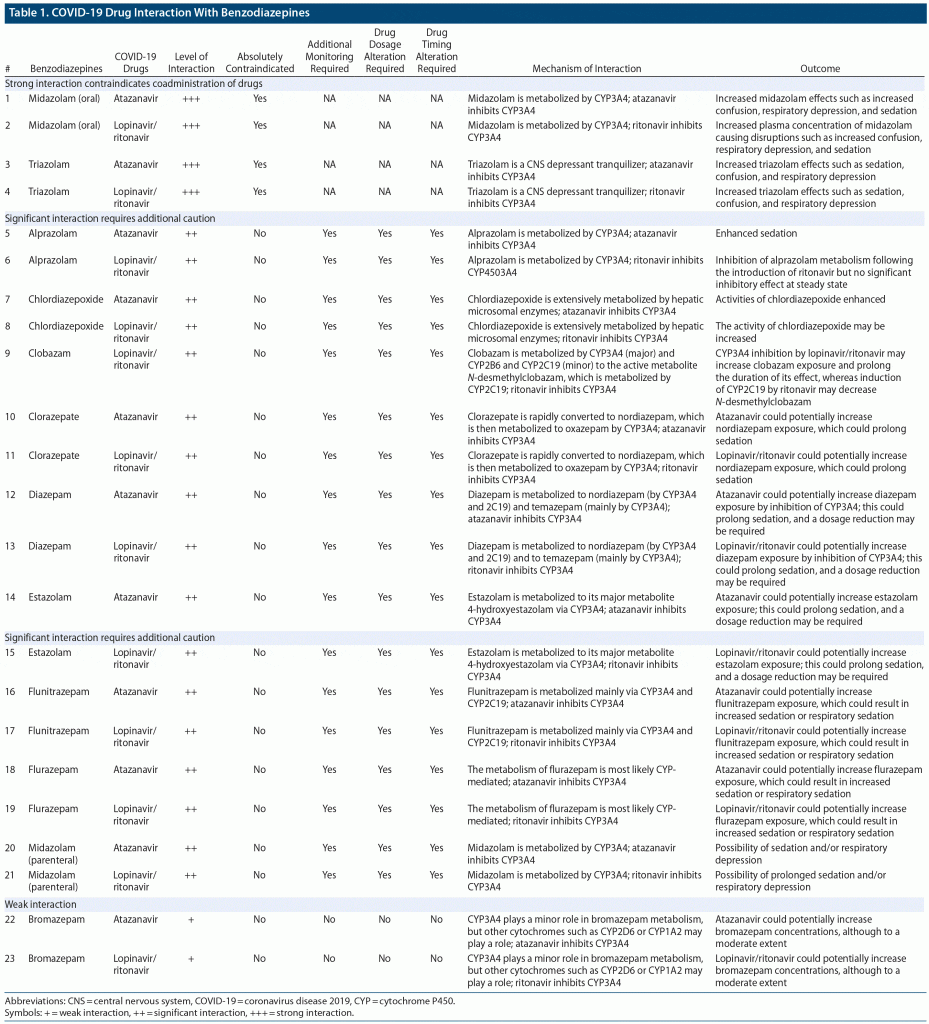
Prim Care Companion CNS Disord 2021;23(6):21br03081
To cite: Shah K, Kamrai D, Srinivas S, et al. Benzodiazepine interaction with COVID-19 drugs. Prim Care Companion CNS Disord. 2021;23(6):21br03081.
To share: https://doi.org/10.4088/PCC.21br03081
© Copyright 2021 Physicians Postgraduate Press, Inc.
aGriffin Memorial Hospital, Norman, Oklahoma
bDepartment of Psychiatry and Behavioral Sciences, Oklahoma State University, Tulsa, Oklahoma
cA.J. Institute of Medical Sciences and Research Center, Mangalore, Karnataka, India
dTexas Tech University Health Sciences Center El Paso, El Paso, Texas
eDepartment of Psychiatry, Texas Tech University Health Science Center at Odessa/Permian Basin Odessa, Midland, Texas
fBoston Children’s Hospital/Harvard Medical School, Boston, Massachusetts
*Corresponding author: Kaushal Shah, MD, MPH, 900 E Main St, Norman, OK 73071 ([email protected]).
The coronavirus disease 2019 (COVID-19) pandemic has adversely impacted social, financial, and health care aspects of people’s lives globally.1-4 It has led to an increase in anxiety, panic attacks, and insomnia, causing an increase in the use of benzodiazepines.2,3,5,6 Benzodiazepines are one of the most commonly prescribed medications for anxiety, insomnia, and epilepsy.5 According to the US Food and Drug Administration (FDA), in 2019 about 92 million benzodiazepine prescriptions were dispensed in the United States.5 About 5 million US adults have reported misuse of benzodiazepines out of a total of 30 million users.7 Abuse and misuse of benzodiazepines have caused a higher volume of emergency department visits, especially with the concurrent use of other substances and prescribed medications.8 At the same time, several medications are being used to manage and treat COVID-19 patients.9 However, limited evidence has been brought to light thus far regarding the interaction of these drugs with benzodiazepines, their mechanisms of action, and the outcomes of these interactions when utilized in humans. Since the drug-to-drug interaction with clinical significance was only found between the antiviral class of drugs for COVID-19 and benzodiazepines, we reviewed the potential drug-to-drug interactions and safety of using benzodiazepines with COVID-19 antiviral drugs.9
One such antiretroviral treatment is the combination of ritonavir and lopinavir. Ritonavir is a potent cytochrome P450 (CYP) 2D6, 3A4, and 1A2 inhibitor and a CYP2B6 and CYP2C19 glucuronidation inducer.10 On the other hand, lopinavir is metabolized by CYP3A4. Since the cytochrome system also metabolizes benzodiazepines, combining it with a low dose of ritonavir and lopinavir facilitates the inhibition of its metabolism and exaggerates its effects.10
Drug-To-Drug Interactions of Benzodiazepines and COVID-19 Antivirals
Midazolam (oral) is a benzodiazepine metabolized by CYP3A4.10 Coadministration of midazolam with a CYP3A4 inhibitor, such as ritonavir, may promote increased midazolam concentration.9,10 Outcomes of this interaction are disruptions such as increased confusion, respiratory depression, and sedation due to increased plasma concentrations of midazolam.9 Therefore, this combination is highly contraindicated for coadministration.9
Atazanavir is another CYP3A4 inhibitor, and its concurrent use with oral midazolam facilitates possible severe events such as prolonged sedation, increased confusion, and respiratory depression.9 The combined use of atazanavir with oral midazolam is contraindicated due to their potential adverse interaction. The combination of parenteral midazolam with atazanavir should be applied cautiously, with close clinical monitoring and dose and administration interval alternation to avoid respiratory depression. Reducing midazolam’s dose has also been recommended.9
Triazolam is widely regarded as a drug for the treatment of insomnia.11 It is also considered a central nervous system (CNS) depressant tranquilizer, which increases the triazolam effects such as sedation, confusion, and respiratory depression when combined with atazanavir.9 Furthermore, with ritonavir being a CYP3A4 inhibitor, its concomitant use with triazolam causes a similar effect as the triazolam-atazanavir combination and is not recommended.9
Alprazolam is metabolized by CYP3A4, and coadministration with atazanavir results in a possibility of enhanced sedation.9 It is recommended that doses of alprazolam be reduced to prevent the undesirable effects of the combination. In addition, alprazolam plus ritonavir can cause inhibition of alprazolam metabolism without noticeable inhibitory effects in its steady state.9 While there are contrasting results, studies consistent with these findings also found psychomotor retardation to be an effect of the combination.12
Chlordiazepoxide is commonly utilized to treat minor mental illnesses.13 It is extensively metabolized by the hepatic microsomal enzymes. The combined use of chlordiazepoxide with atazanavir or ritonavir can enhance its activity, posing a greater risk of adverse effects such as sedation, memory impairment, ataxia, and respiratory depression.9
Clobazam is effective for the management of generalized seizures.14 It is metabolized by CYP3A4, CYP2B6, and CYP2C19.9 Use of clobazam with ritonavir increases the exposure of clobazam and prolongs the duration of its effects and hence requires constant monitoring for side effects by a clinician.2,9
Clorazepate is used as an anticonvulsant and anxiolytic to manage and treat epilepsy, anxiety, and alcohol abuse.15 Clorazepate is rapidly converted to nordiazepam and, in turn, is metabolized to oxazepam by CYP3A4. Its interaction with a CYP3A4 inhibitor such as atazanavir or ritonavir could increase clorazepate’s concentration and lead to prolonged sedation.9 Thus, dose reduction may be required.9,15
Diazepam is used to manage seizures in prehospital settings.16 Diazepam is metabolized by CYP3A4 and CYP2C19 to nordiazepam and tamazepam.9,10 When diazepam is combined with ritonavir or atazanavir, its effects may be prolonged.10 The University of Liverpool reported similar findings—that concurrent administration of diazepam with ritonavir or atazanavir could lead to prolonged sedation, likely requiring dosage reduction.9
Estazolam is used in the management and treatment of insomnia.17 It is metabolized to its primary metabolite 4-hydroxyl estazolam through CYP3A4.9 The coadministration of estazolam and CYP3A4 inhibitors atazanavir or ritonavir could potentially lead to more exposure and thereby prolonged sedation.9 It is recommended that there should be a dosage reduction to alleviate these effects.
Flunitrazepam is used as a preanesthetic agent and a sedative in the treatment of insomnia.18 It is mainly metabolized through CYP3A4 and CYP2C19.9 Combining flunitrazepam with CYP3A4 inhibitors such as atazanavir and ritonavir can increase its exposure, leading to respiratory sedation.9 A dosage reduction is recommended.
Flurazepam is widely used to manage sleep disorders.19 Its metabolism is CYP-mediated. Though not studied, its combination with CYP3A4 inhibitors could increase respiratory sedation, and a dosage reduction is recommended.9
Bromazepam exhibits anxiolytic properties and is used for anxiety disorders.20 Metabolism of bromazepam is carried out by CYP3A4 (minor) and CYP2D6 or CYP1A2. Bromazepam’s concentration may moderately increase with concurrent use of CYP3A4 inhibitors (atazanavir and ritonavir). Since the drug-to-drug interactions are potentially weak, additional actions and close monitoring are not suggested.9 Further details are provided in Table 1.5,6,9,10,13,14,18-20
In conclusion, benzodiazepines have shown significant levels of interaction with COVID-19 drugs. When benzodiazepines are indicated, it is better to use temazepam, oxazepam, or lorazepam over alprazolam, as the liver does not metabolize them.1 There is also a need for further research to evaluate the safety of adjunct therapy. Since benzodiazepines are so commonly prescribed, physicians need to keep these interactions in mind and exercise caution when they are prescribed together to avert any severe or fatal reactions.
Received: July 26, 2021.
Published online: October 28, 2021.
Potential conflicts of interest: None.
Funding/support: None.
Additional information: Drs Shah and Kamrai share equal credentials for first authorship. Drs Trivedi and Mansuri share equal credentials for senior authorship.
References (20)

- Who coronavirus (COVID-19) dashboard. WHO website. Accessed May 15, 2021. https://covid19.who.int
- Shah K, Kamrai D, Mekala H, et al. Focus on mental health during the coronavirus (COVID-19) pandemic: applying learnings from the past outbreaks. Cureus. 2020;12(3):e7405. PubMed CrossRef
- Shah K, Mann S, Singh R, et al. Impact of COVID-19 on the mental health of children and adolescents. Cureus. 2020;12(8):e10051. PubMed CrossRef
- COVID-19 at the 1-year mark: how the pandemic has affected the world. Medical News Today website. 2021. Accessed May 15, 2021. https://www.medicalnewstoday.com/articles/global-impact-of-the-covid-19-pandemic-1-year-on
- FDA orders stronger warnings on benzodiazepines. Medscape website. Accessed May 15, 2021. https://www.medscape.com/viewarticle/937997
- Agrawal R. Careful prescribing of benzodiazepines during COVID-19 pandemic: a review. J Ment Health Clin Psychol. 2020;4(4):13–16.
- Benzodiazepine use, misuse spike in the US. Medscape website. Accessed May 15, 2021. https://www.medscape.com/viewarticle/906851
- Benzodiazepines implicated in high rate of ED visits. Medscape website. Accessed May 15, 2021. https://www.medscape.com/viewarticle/925686
- Liverpool covid-19 interactions. University of Liverpool website. Accessed May 15, 2021. https://www.covid19-druginteractions.org/
- Mansuri Z, Shah B, Adnan M, et al. Ritonavir/lopinavir and its potential interactions with psychiatric medications: a COVID-19 perspective. Prim Care Companion CNS Disord. 2020;22(3):20com02677. PubMed CrossRef
- Cohn JB. Triazolam treatment of insomnia in depressed patients taking tricyclics. J Clin Psychiatry. 1983;44(11):401–406. PubMed
- Greenblatt DJ, von Moltke LL, Daily JP, et al. Extensive impairment of triazolam and alprazolam clearance by short-term low-dose ritonavir: the clinical dilemma of concurrent inhibition and induction. J Clin Psychopharmacol. 1999;19(4):293–296. PubMed CrossRef
- López-Muñoz F, Álamo C, García-García P. The discovery of chlordiazepoxide and the clinical introduction of benzodiazepines: half a century of anxiolytic drugs. J Anxiety Disord. 2011;25(4):554–562. PubMed CrossRef
- Arya R, Giridharan N, Anand V, et al; Cochrane Epilepsy Group. Clobazam monotherapy for focal or generalized seizures. Cochrane Database Syst Rev. 2018(7):CD009258.
- Livertox: Clinical and Research Information on Drug-Induced Liver Injury. Bethesda, MD: National Institute of Diabetes and Digestive and Kidney Diseases; 2012.
- Verrotti A, Milioni M, Zaccara G. Safety and efficacy of diazepam autoinjector for the management of epilepsy. Expert Rev Neurother. 2015;15(2):127–133. PubMed CrossRef
- Schroeck JL, Ford J, Conway EL, et al. Review of safety and efficacy of sleep medicines in older adults. Clin Ther. 2016;38(11):2340–2372. PubMed CrossRef
- Dinis-Oliveira RJ. Metabolic profile of flunitrazepam: clinical and forensic toxicological aspects. Drug Metab Lett. 2017;11(1):14–20. PubMed CrossRef
- Martello S, Oliva A, De Giorgio F, et al. Acute flurazepam intoxication: a case report. Am J Forensic Med Pathol. 2006;27(1):55–57. PubMed CrossRef
- Machado D, Bastos VH, Cunha M, et al. Effects of bromazepam in qEEG by type writing. Arq Neuropsiquiatr. 2005;63(2b):452–458. PubMed CrossRef
Enjoy free PDF downloads as part of your membership!
Save
Cite
Advertisement
GAM ID: sidebar-top





